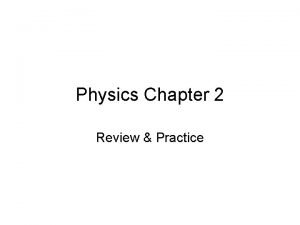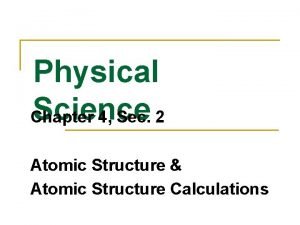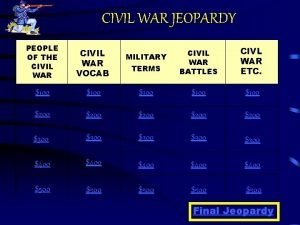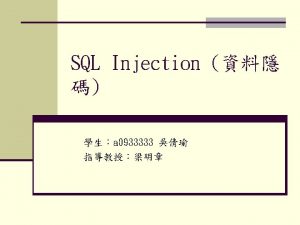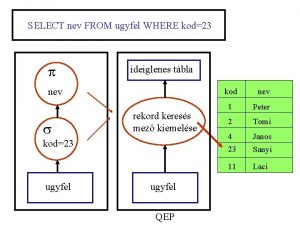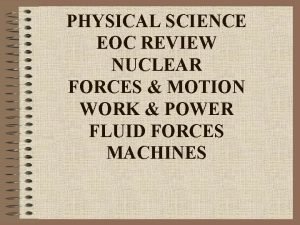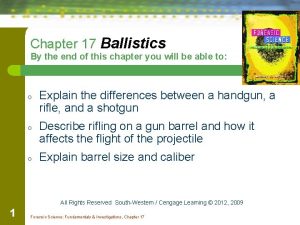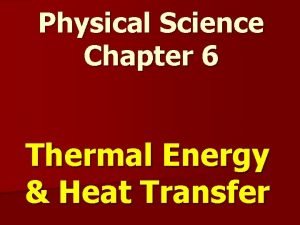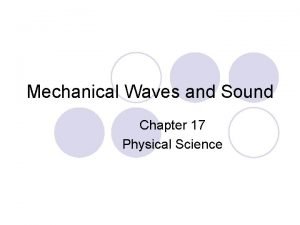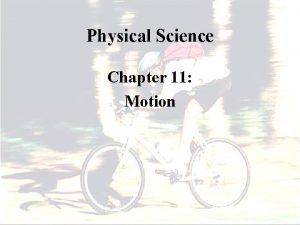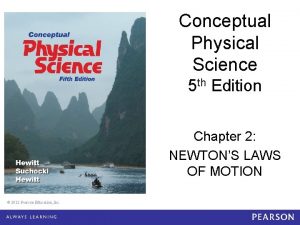JEOPARDY Physical Science Chapter 14 Review Game Select











































- Slides: 43

JEOPARDY Physical Science Chapter 14 Review Game

Select a Category Work and Power Efficiency Machines Mechanical Advantage 1 point 2 points 3 points 4 points 5 points

Work and Power Work is commonly measured in this unit. 1 point Check

Work and Power What is the Joule? 1 point Back to Category Slide

Work and Power is commonly measured in this unit. 2 points Check

Work and Power What is the Watt? 2 points Back to Category Slide

Work and Power A weightlifter uses 800 N of force to lift a barbell. If the distance he lifts the barbell is 0. 75 m this is the work done on the barbell. 3 points Check

Work and Power What is 600 Joules? 3 points Back to Category Slide

Work and Power A book is lifted from the floor to a bookshelf 1. 25 m straight up. A force of 225 N is exerted in 1. 5 seconds. This is the power used. 4 points Check

Work and Power What is 187. 5 Watts? 4 points Back to Category Slide

Work and Power A boy is exerting 100 watts of power while scooping snow. If he scoops snow for 10 minutes this is how much work he does. 5 points Check

Work and Power What is 60, 000 Joules? 5 points Back to Category Slide

Efficiency The reason why a machine can never have 100% efficiency. 1 point Check

Efficiency What is friction? 1 point Back to Category Slide

Efficiency A 4 meter ramp is used to lift a 300 N box up a distance of 1. 5 meters. 175 N of force is used to push the box up the ramp. This is the efficiency of the ramp. 2 points Check

Efficiency What is 64%? 2 points Back to Category Slide

Efficiency A machine that uses 1245 J of work to operate and applies 850 J of work on a crate has this for efficiency. 3 points Check

Efficiency What is 68% efficiency? 3 points Back to Category Slide

Efficiency A machine is considered efficient if it is 85% effective. If the work input is 950 J, this would be the work output. 4 points Check

Efficiency What is 807. 5 J of work? 4 points Back to Category Slide

Efficiency A 15 meter long ramp is used to put cars onto the 2 nd level of a building that is 4 meters high. A car has a weight of 500 kg and a force of 1600 N is used to push it up the ramp this is the efficiency. 5 points Check

Efficiency What is 81. 7% efficiency? 5 points Back to Category Slide

Machines List the six simple machines. 1 point Check

Machines What are the lever, pulley, screw, wedge, inclined plane, and wheel and axel? 1 point Back to Category Slide

Machines This simple machine type has 3 different classes. 2 points Check

Machines What is the lever? 2 points Back to Category Slide

Machines The name of the pulley system pictured to the right. 3 points Check

Machines What is a compound or block and tackle pulley? 3 points Back to Category Slide

Machines The location of the fulcrum for a first class lever. 4 points Check

Machines What is between the input arm and the output arm? 4 points Back to Category Slide

Machines A knife, chisel, and ax blade are considered this type of simple machine. 5 points Check

Machines What is a wedge? 5 points Back to Category Slide

Mechanical Advantage The ideal mechanical advantage of the pulley system pictured to the right. 1 point Check

Mechanical Advantage What is 4? (remember the number of ropes of a pulley system equals it IMA; excluding the one you are pulling on. ) 1 point Back to Category Slide

Mechanical Advantage Input(radius) / Output(radius) = MA A steering wheel has a radius of 14 cm and the axle has a radius of 2. 5 cm. This the MA of the wheel and axel. 2 points Check

Mechanical Advantage What is 5. 6 MA? 2 points Back to Category Slide

Mechanical Advantage MA = Distance of ramp / Height of ramp A ramp has a height of 3. 5 meters and a distance of 12. 4 meters. This is the MA of the ramp. 3 points Check

Mechanical Advantage What is 3. 5 MA? 3 points Back to Category Slide

Mechanical Advantage MA = input arm / output arm A lever has an output arm length of 25 cm and an input arm of 100 cm. This is the MA of the lever. 4 points Check

Mechanical Advantage What is 4 MA? 4 points Back to Category Slide

Mechanical Advantage The elephant weighs 2000 N. This is the force the monkey is using to pull him up. 5 points Check

Mechanical Advantage What is 400 N? 5 points Back to Category Slide

Congratulations! You have completed the game of Jeopardy.
 Physrt
Physrt Chapter 14 physical science test
Chapter 14 physical science test Physical science jeopardy
Physical science jeopardy Chapter 4 review physical science
Chapter 4 review physical science Chapter 14 review physical science
Chapter 14 review physical science Physical science chapter 5 review
Physical science chapter 5 review As your room gets messier day by day, entropy is
As your room gets messier day by day, entropy is Chapter 16 review physical science
Chapter 16 review physical science Genetics jeopardy review game
Genetics jeopardy review game Jeopardy civil war
Jeopardy civil war Evolution jeopardy review game
Evolution jeopardy review game Ww1 jeopardy
Ww1 jeopardy I fear too early for my mind misgives literary devices
I fear too early for my mind misgives literary devices Ap world history jeopardy review game
Ap world history jeopardy review game Ap world history jeopardy review game
Ap world history jeopardy review game Jeopardy science questions
Jeopardy science questions Select * from select
Select * from select Ameadmin
Ameadmin Select * from select
Select * from select Select * from select
Select * from select Periodic table jeopardy
Periodic table jeopardy Noah carried a skateboard
Noah carried a skateboard Physical science eoc study guide
Physical science eoc study guide Physical science eoc review
Physical science eoc review Chapter 4 section 1 work and machines answer key
Chapter 4 section 1 work and machines answer key Mind map main branches of science
Mind map main branches of science Natural and physical science
Natural and physical science My favourite subject english for class 6
My favourite subject english for class 6 Chapter review motion part a vocabulary review answer key
Chapter review motion part a vocabulary review answer key Forensic science chapter 18 review answers
Forensic science chapter 18 review answers Is water that contains waste from homes or industry
Is water that contains waste from homes or industry Nibis definition forensics
Nibis definition forensics Forensic anthropology unit
Forensic anthropology unit Chapter 13 environmental science
Chapter 13 environmental science Chapter 8 environmental science
Chapter 8 environmental science Chapter 2 assessment environmental science answers
Chapter 2 assessment environmental science answers Chapter 3 review 8th grade science
Chapter 3 review 8th grade science The science of biology chapter 1 assessment answers
The science of biology chapter 1 assessment answers Environmental science chapter 10 review answers
Environmental science chapter 10 review answers Chapter 6 physical science
Chapter 6 physical science Chapter 17 mechanical waves and sound
Chapter 17 mechanical waves and sound Chapter 11 physical science
Chapter 11 physical science Conceptual physical science practice sheet chapter 2
Conceptual physical science practice sheet chapter 2 Jeopardy disney questions
Jeopardy disney questions
